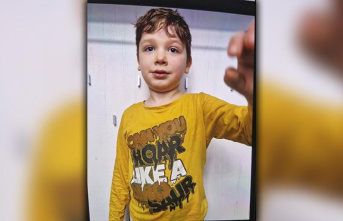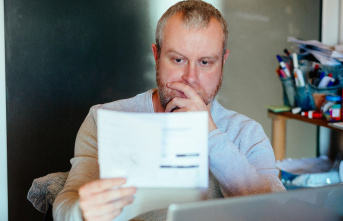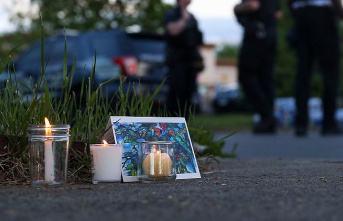In the meantime, the corona measures hardly play a major role, and the incidences are falling significantly. In January it was different - the heaviest wave was still to come. In the Berlin-Neukölln health department, it becomes clear what the past two years have been like for the authorities.
Bremen already has it behind them. Nine mask wearers look at what is now also approaching Berlin-Neukölln. The sun shines through the old building's double window onto a conference table that has been pushed together from several tables. It is 11:30 a.m. on January 3, 2022. The pandemic staff representatives of the health department are meeting for the first time this year. A projector projects a graphic onto the wall. You are studying a curve that is rising almost vertically. It is the number of the very first omicron cases in Berlin-Neukölln. The Omicron wave is rolling towards Germany.
These nine discuss how the approximately 330,000 Neukölln residents can get through the corona pandemic as well as possible. Medical officer Nicolai Savaskan is also in the room. He's the only one wearing a suit. It's not the only meeting of the day for Savaskan. Later he will sit on the crisis team with the district mayor, after which he will introduce himself to the new Berlin Senator for Health.
But before that, numbers are discussed. The Robert Koch Institute (RKI) reports 18,518 new infections for Germany on the first Monday of the year, and 479 for the capital. Compared to what will come and become commonplace, the numbers are negligible. A district from Thuringia took first place in the hotspot list. But it's eighth place on the table that gets the most attention. Bremen is the very first omicron hotspot in Germany and a city-state like Berlin.
Everything that the Hanseatic city is going through will also affect Berlin-Neukölln. Almost four weeks later, the health department will switch to emergency operation, as the official doctor Savaskan calls it. Forecasts would have predicted incidence levels of over 1,000 for the district, with the true peak at the end of January at 2,806. Even if no one panics in this first week of January, the medical officer will later call the situation a "moment of terror". The staff is not sufficient for such incidence values, the prepared warning level concept comes into force. Control has to be handed over bit by bit and personal responsibility has to be relied on.
In Germany, a little more than 400 health authorities are fighting the pandemic. In the past two years they have become the Corona executive. "Although the health department with its various medical areas is an office, it is also a medical facility," explains medical officer Savaskan. These included the child health service, social psychiatry and infection control as well as environmental medicine. With all its departments, the authority is the link between politics and the population. The offices implement what the state governments decide, what determines the everyday life of the people. They arrange quarantines for contact persons, send infected people into isolation, provide information and transmit case numbers to the RKI and the state authorities.
When the pandemic started, they still had to process cases by hand. Today, the laboratories send their test results electronically to the authorities using software. They process the cases and forward them to the state level. But Omikron put this system to the test at the beginning of the year. Laboratories are overloaded, PCR tests are becoming scarce. To date, there is no uniform reporting route to the authorities for positive rapid tests in test centers. So cases have to be entered manually into the system again. It takes people to do that - that puts a strain on the thin staffing level. And there are again forces that are missing elsewhere.
That is why the Neukölln health department has to shut down its corona hotline at the beginning of the year. It is the place where questions can be asked. The hotline remains silent at precisely the time when most people in the district are getting infected.
Overload has become part of everyday life. This is most evident in contact tracing. There are different teams in Neukölln. One only cares about schools, another only about hospitals and nursing homes. They have prioritized themselves before Omikron: contact tracing will focus primarily on care facilities and other vulnerable groups. All younger people will be informed by e-mail or letter. That can sometimes take several days.
Team two mainly looks after adults and the first Omikron cases. On the first Wednesday of the year, it consists of Rebecca Sander, Vanessa Simsek and Kira Mittelstädt. There are four workstations in the room where they sit together. Even when it comes to making a call, the devices don't ring, they're muted. There is very little personal stuff on their desks, mostly office supplies.
She rarely gets off the shift on time, says Sander. She would like to have more time with people. Anything that can't be done today has to be done the next day. That's why she's not too worried about the omicron wave. The number of cases waiting to be processed is already large. Then she gets even bigger. On this January Wednesday they have 2833 open corona requests. "Normal," says Simsek. Not all of them are people who have just tested positive, but they want something from the health department.
In case investigation, every call can become a sensitive matter. Outside, very few people know how overburdened they are. A woman tested positive a month and a half ago. She needs a certificate from the health department that she really had Corona. Before Sandner picks up the phone, she hopes that the woman won't be angry. After all, she's been waiting for a call for weeks. If you explain to people why it sometimes takes longer, most would understand, says Sander. She dials the number and waits.
Case investigators have seen all sorts of stories. For example, phone calls with infected people, with a supermarket checkout ringing in the background. Or people who give inaccurate information about their spouses. Mittelstädt only started there in 2022. She actually comes from the tourism industry. Sandner previously worked in a women's shelter in Switzerland. She says that she also privately educates people about the virus. Simsek has been there the longest. The trained beautician still experienced the paper economy. She says some people cried on the phone when they found out they had the Delta variant. That is no longer the case with Omikron. Some just hung up.
With the woman who called Sander, the worries are in vain - she doesn't even pick up the phone. So it's the other way of contact: by e-mail. To make things go faster, Sander always has a document open on her computer that contains the most important text modules. All you have to do is adapt it and copy it into the mail. The three investigators calculated that they sent around 70 to 80 emails per shift.
In addition to phone calls and emails, the case investigators also have to explain a lot. Actually, after two years of the corona pandemic, most things should be clear. But on the contrary: "It could be made easier," says Sander. This starts with the basics about staying at home with cold-like symptoms. It ends with the fact that some print out their emails, answer questions by hand and send them back by post.
In the past two years they have been in contact with thousands of people. When many of them are suddenly exposed to a hazard, officials call it a major incident. "That's how Corona felt at the beginning," says medical officer Savaskan. There are still such moments at the beginning of January, two days after the briefing. Then there is a lot going on in the office.
The doctor's office door is open. As always, the standing desk is raised, and the office chair that goes with it is on the opposite side of the room. On the other side, boxes with still packed monitors are piled up, on top of which lies a signed rugby ball. The egg-shaped sports device is a souvenir from when an entire team was boosted in the office. Savaskan's telephone and cell phone ring, at one moment it happens that he is having two conversations at the same time and writing an e-mail at the same time.
Employees keep rushing into the office, but they don't seem stressed. Suspicion of a larger outbreak, explains Savaskan. At least a dozen households were affected, all in a residential building. PCR tests are pending. An emergency meeting is called. "It shows what we've learned," says Savaskan. In the summer of 2020, entire blocks of flats were quarantined in Neukölln in a similar situation. At the time it was the right decision, but not from today's perspective, says the medical officer. This time they get the outbreak under control without any major measures. Today they know more.
The wealth of experience after two years of the corona pandemic is now enormous. Berlin-Neukölln is always in the national headlines. Corona waves are announced in the district before they become visible in the rest of the country. Neukölln is densely populated, many work in jobs where home office is not possible. In October 2020, the Berlin district will become a nationwide hotspot. And despite everything: Medical officer Savaskan never had a bad feeling, he says in retrospect.
One reason for this is the pandemic staff, with which a new authority has been growing within the health department since March 2020. The staff takes on everything to do with the corona virus: the situation overview, reporting the daily number of cases to the RKI, phoning citizens, testing in our own test center, vaccination during campaigns.
At the beginning of January, 172 people work in the office, who primarily take care of the Corona concerns of the people of Neukölln. One of them is Cem Canpolat. He previously worked at an e-scooter company. In December 2020 he decides to do something to fight the pandemic. Initially he looked after nursing homes. Looking back, he tells of a hard time. There were no vaccinations yet, one person died almost every day.
Canpolat will lead the organization of the pandemic team until the end of April. In January he said that he was a little bit out of touch with the people there. When asked about the past two years, Canpolat says: "The waves aren't the worst part," adding, "It's the duration of the pandemic." He says he's not good at switching off. And yet: The people who work in the health department would know what to expect. "Those who work here also want to be here," says Canpolat.
"The pandemic has brought the health department together," says medical officer Savaskan. Despite the overload and new possible variants, he is confident about the future. It has become something of a routine. The load is now more predictable than it was a year and a half ago. Even if some corona decisions have changed weekly, another thing makes work easier for everyone in the health department.
In his office, the medical officer points to a stack of stapled sheets. "We also did some science on the side," he says. It is a study on corona outbreaks in nursing homes in Neukölln. He begins to leaf through the pages, pauses briefly, and then points to a graphic. In April 2020, in one of the old people's homes examined, the death rate was seven times higher than in the previous year. Today that doesn't happen anymore. "The vaccination was a great relief for everyone," says Savaskan. It's insights like this that make him happy to do his job.
6












